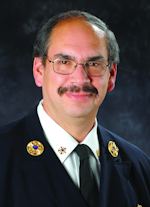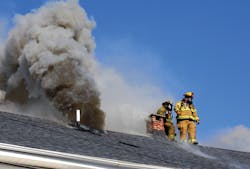PAWTUCKET, RI, JAN. 6, 2012 – Three engines, two ladders and a rescue responded to a late-morning report of a house fire. First-arriving Engine 1 reported smoke showing and gave a “Code Red” – the signal for a working fire. The fire was located on the top floor of an occupied 2½-story dwelling.
As lines were being stretched, ladder company members started an interior search for occupants. Command requested Ladder 1 to begin vertical ventilation. The aerial ladder was positioned on the D side and raised to a dormer to the C side. The members walked across the roof ridge to the point where they cut a ventilation hole. Black smoke was churning from the hole, but there was no visible fire. Firefighters on the top floor reported heavy smoke and severe heat, but no visible fire.
As the firefighters on the roof made their way back to their aerial, they realized they were cut off by spreading fire. Ladder 2’s aerial was on the B side and the firefighters would have to pass the vent hole they had cut to get to Ladder 2. Firefighters on the ground, observing what was happening on the roof, were raising a ground ladder.
The section of roof on which the firefighters were standing burned through, sending one member tumbling down the pitched roof. In a desperate fight for his life, the firefighter was able to stop his fall about one foot from the edge. Upon seeing that occur, his officer immediately made an effort to assist the firefighter, but he too fell through the burned section and became trapped by what was left of that area of the roof. Surrounded by intense heat and smoke, the officer was now in a battle for his own life and struggled to extricate himself from the hole. The officer remained calm and removed himself from the hole. Realizing that they had to get off the roof as soon as possible, the firefighters made their way to the B side and down Ladder 2. Both firefighters were checked and removed to the hospital for burns and other injuries. Units inside were withdrawn and a defensive attack was started. The fire was controlled in one hour.
— Tom Carmody
A
After cutting a ventilation hole, two firefighters prepare to exit the roof.
B
Another ladder company operates while firefighters open the roof. A second alarm was requested a few minutes after arrival, bringing three more engines.
C
The roof suddenly gives way. One firefighter tumbles down the roof; apparently his breathing apparatus helped him stop. The other firefighter loses his helmet as his leg becomes caught.
D
The first firefighter stops one foot from the edge. Conditions in the attic start to change.
E
The firefighter remains calm and eventually extricates himself from the weakened roof.
F
Fire vents from the area where the firefighter had been trapped.
G
The firefighters gingerly walk off the roof after their close call.
H
After the firefighters exited the roof, the fire attack was shifted to defensive. Five handlines and two ladder pipes operated. Half of the roof burned away.
?

Harvey Eisner | Editor Emeritus
HARVEY EISNER was named Editor Emeritus of Firehouse® after serving 15 years as Firehouse's Editor-in-Chief. He joined the Tenafly, NJ, Fire Department in 1975 and served as chief of department for 12 years. He was a firefighter in the Stillwater, OK, Fire Department for three years while attending Oklahoma State University. Eisner was an honorary assistant chief of the FDNY and program director for the Firehouse Expo, Firehouse World and Firehouse Central conferences. He covered many major fires and disasters and interviewed numerous fire service leaders for Firehouse®






